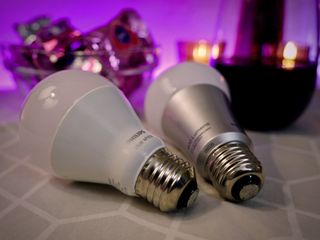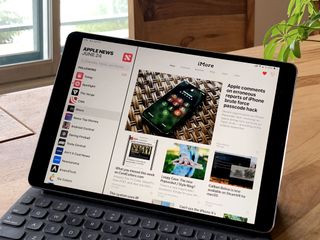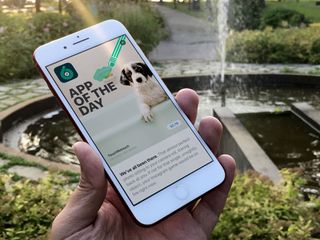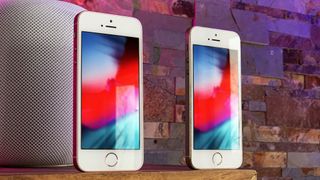Apple's biggest misses of 2018

Every year, to end the year, I put together lists of what I think Apple did best and worst for the last 12 months. I'll have the best list up in a couple of days but, for now, I'm going to spend a cold minute focusing on the negative: What Apple got wrong and how I'd like to see it fix things for next year.
Not because I'm a jerk or a hater or everything else I get called every time I do this, but because every up has its down, every success hides some failure, and there's no company or product that is really so great it can't possibly get any better.
So, what made this year's list?
Siri
Siri is going to go down as one of the biggest unforced errors in Apple's history. After being first-to-market with the service as part of iPhone 4s, mismanagement and neglect led Apple to not only lose its huge lead to the likes of Amazon and Google, and maybe even Microsoft and Samsung, but to leave its customers with over a half a decade of subpar, error-prone, and in some cases simply broken service.

Apple did make strides in 2018. It moved Siri out from under Eddy Cue to Craig Federighi and then to freshly-hired-from-Google, and blessedly-AI-focused John Giannandrea. It also managed to ship HomePod in the spring, not only with AirPlay and a host of longstanding core audio issues fixed but with a really good, if severely limited Siri implementation.
But Apple is still so far behind that absolutely no pressure can be let up. It's going to take everything the company has, every ounce of commitment, focus, resolve, and funding the company has to dig itself out and start building itself up.
I made a video earlier this year that included making Siri more personal, so it understands our contexts better and can be more conversational, expand SiriKit and Shortcuts so that they're more useful to more people across more use cases, make Siri more consistent so it works as similarly as possible across all devices and regions, turn Siri into a mesh network so all nodes are part of a bigger, more useful collective, but ultimately just work towards SiriOS.
Master your iPhone in minutes
iMore offers spot-on advice and guidance from our team of experts, with decades of Apple device experience to lean on. Learn more with iMore!
Because not having an interface that includes voice and AI as first-class options is soon going to be like not having multitouch… or graphics.
And it's not just a problem for Apple, given how terrible Facebook, Google, and maybe even Amazon — I'm honestly not sure about them yet — have been with privacy and security, having a competitive Siri isn't just nice, it's necessary. Without it, people are going to choose data harvesting that does what they want over privacy that frustrates and fails them almost every time.
Because of Giannandrea's hire, his reporting directly to Tim Cook, and the amount of Siri job listings going up and up I'm not willing to bet but I'm willing to hope again that series improvements and updates are being readied for the near future.
HomeKit
Apple typically owns the mindshare in any category in which it competes. Even if you don't have an iPhone or iPad or Apple Watch or Mac, you hear all about them. You know all about them. They get copied by almost all other vendors, and they're the grade almost every other vendor's products are curved against.

Now that the smartphone market is beyond mature, though, and has become the platform upon which everything else is being built, it's not so much the big things that matter anymore but a multitude of many smaller things. Including HomeKit things.
And Apple doesn't have the same mindshare there. It just doesn't. And that was beyond notable last CES.
Amazon and Alexa were — everywhere — and Google and its home products weren't far beyond. Apple hadn't released HomePod yet but HomeKit has been out for years… it just didn't get anywhere nearly as much attention. And it didn't demand it either.
First, Apple doesn't attend CES. Well, not in a public-facing capacity at least. Back in the days of Macworld Expo, that didn't matter. The iPhone launch, the MacBook Air unveiling… it wasn't uncommon for Apple to completely overshadow the bigger, louder show completely.
But for the last long while, Apple hasn't done anything big until March or June. And it hasn't really mattered because no one else was really doing anything big at the beginning of the year either.
Now we have all the connected health and home and other devices, and everyone not Apple gets the spotlight all to themselves.
The branding doesn't really help either. Works with Alexa, Works with Google Home… Works with HomeKit? HomeKit is a framework. All Kits are in Apple land, going back to AppKit and UIKit, and forward to SiriKit and ARKit.
But they've never been used as part of public marketing before. App buttons, for example, don't say "Works with UIKit". They say "Download from App Store"!
"Works with Siri" like "Works with Alexa" would be great if Siri had been rock solid for years already, but an even better, even more encompassing, even more consistent brand would be Apple Home as in Apple Logo Home, like Apple Watch, Apple TV, and Apple Music.
It's not a huge thing but huge things never are. It's just shorter, sweeter, simpler, and more welcoming.
And if Apple could figure out a way to be at CES or to counter-program CES again, maybe just as a sequel to the Rock using Siri around the house — anything that demands attention, well, maybe, just maybe Apple wouldn't be excluded from that conversation early next year. It wouldn't own it, but it would start being part of it.
International
Apple shipped Music to 100 countries on day one. It has editorial teams in many regions, discovering and promoting local talent, and otherwise doing some pretty amazing things for the industry and for listeners.

For a long time, Apple has had a consequential lead internationally, providing media and other services, even Siri language support, in far more places and languages than anywhere else.
But, over the last few years, that seems to have slowed down.
Apple news was announced as part of iOS 9 in 2015. It launched in the United States with Australia and the U.K. following soon thereafter. Then… nothing. Over three years of nothing.
No doubt News is non-trivial, requiring editors and arrangements with publications on a local level. But, again, Apple Music, 100 countries at launch, editors everywhere.
Maybe Apple is waiting to launch its new Texture-based magazine and newspaper subscriptions service before adding new countries, but if so, at the very least, it could have offered basic add-your-own-feeds to every other region in the meantime.
In the age of the internet, there's no reason I shouldn't be able to read Daring Fireball or Six Colors in the News app no matter where I live from day one.
By the same token, there are many places still waiting on basic Siri service, on the TV app, on HomePod, Apple Pay, and, outside the U.S., on Apple Pay cash.
Initially, Apple often lists countries where products and services will be coming next. But after a while, that dries up, and no one knows what to expect and when. I understand the desire not to create expectational debt — to shut up and ship. But that only works if you ship.
I have no idea how difficult those services are to roll out internationally, but we do know that we're customers, just like everybody else, and we pay for our Apple devices, just like everyone else — and in some cases, thanks to exchange rates, tariffs, and taxes, way more than many others — and we get fewer, sometimes far fewer features and services for our money.
And I get that having to deal with international financial institutions is no walk in the park for Apple Pay, and having to tune Siri for every dialect across multilingual titles and with vastly different metadata in every region makes HomePod launches take longer than people assume.
But making the News and TV apps available everywhere, all at once, with whatever open feeds and local apps can work with them now would be a good start.
App Store
The biggest now-now-now problem in the App Store this year and for a few years now has been scam apps. Apps that trick people into egregiously expensive subscriptions and essentially steal their money for a period of time.

Developer David Barnard has done a great job documenting the problem and Apple has so far done a terrible job at fixing it.
Some have suggested Apple doesn't want to fix it because it would negatively impact App Store revenue. I don't believe that. Apple, historically, has been really good at seeing the long-term value of taking short-term hits if it improves customer experience.
But, whatever the reason, it is and always has taken Apple far too long to address App Store abuse. The company will kill an app even by a well known and loved indie developer in an instant if it wants to send a message about user experience or some guideline or another, but knock-offs and scams persist for weeks and months. Apple just has to do better here. Because customers literally being ripped off is a far bigger and more important problem than a calculator being stuffed into a widget or an iPhone icon showing up in an app.
Since Phil Schiller has taken over the U.S. App Store we've seen a long series of qualitative improvements, from review times to updated guidelines to a whole new store. If 2019 is the year Apple solves for scams, I think everyone would be profoundly better off.
Scaling
I've been on the fence about including scaling in this list again this year. Here's what I said last year:

Once upon a time, Apple made desktop computers. Now, Apple makes computers for your desk, lap, living room, hands, pockets, wrists, and ears. And they're working on more. They're also working on everything that runs and plays on all those computers, both in terms of software and services.Yet, through it all, Apple has maintained its functional organization and small, focused team-based approach.Our greatest strength is often our greatest weakness. So too, Apple's culture. It's what lets the company do so much but what also causes so much to be left undone.I'm not one of the people who think Apple needs to abandon its past to better serve the future. I don't think Apple needs to or should become IBM or GE. I think Apple can have its culture and scale it too. But I think it's got to do a much, much better job shoring up its foundations as it keeps building.It shouldn't take a come-to-Jesus moment to get us to the next Mac Pro and Pro Display. It shouldn't be three or more years without Mac mini refreshes or Continuity for media. Siri still shouldn't feel like there's one server on the farm that just can't handle questions and we all hit it randomly a few times a day or week. It shouldn't take HomePod to get AV rock solid. It shouldn't take the worst possible headlines to get Apple to properly explain battery-based throttling. And it absolutely shouldn't take root/blank and other exploits being posted in public to get the security teams engaged and quality assurance overhauled.For a company so good at fusing efficiency cores with performance cores, wide angle with telephoto lenses, local storage with online, SSD with HDD — and making sure it fills the gaps at the bottom left by profound increases at the top — it makes me wonder if a similar approach couldn't work for Apple itself. Continue to let the teams run as fast as they can and work on all the new features that Apple and customers want to see. But slide in other teams behind them that focus exclusively on maintaining and improving what's already there.These are all growing pains. The problems that come with a company based on focus having to focus on multiple things at the same time. They're problems of scale.But unless Apple wants to go back to only making one or two products, its the core problem Apple absolutely has to solve in 2018.
In large part, I think Apple has addressed many of these issues. It pushed back HomePod to fix underlying problems with audio and to solidify Siri. It pushed back some of iOS 12 to iOS 13 so that key engineers could work on performance improvements instead. It updated and shipped a new Mac mini and a new MacBook Air.
And, yeah, I'll pause so you can hit me with your absolute best finally.
We got new Apple Watch and iPad Pro designs, and a new iPhone with XR.
There are a few things we didn't get, though. No Amber Lake MacBooks or Coffee Lake iMacs. And while Apple canceled the AirPort Extreme and repeated that a new Pro Display will be coming as soon as next year with the new modular Mac Pro, the iPad mini and iPod Touch are still in limbo.
So, I'm going to say I've gone from being cautiously pessimistic to cautiously optimistic that Apple has figured out how to handle a functional organization at scale. But, I'm going to keep it on the list for another year just to see if Apple can keep up both the focus on quality and on quantity in 2019.
Pricing.
A lot of people have been complaining that Apple's prices have gotten too high. I think there is an argument to be made that higher prices, while great for Wall Street and its never-ending thirst for higher average sale price — ASP — starts pricing people out of the Apple ecosystem.

On the flip side, Apple isn't simply charging more for the same products, it's making more expensive products and then charging roughly the same margins on them. The iPhone X series are expensive products to make. Same with the new iPads. Same with the new Macs. And those are the products Apple wants to make.
But if people start perceiving Apple differently, as going from affordable luxury to luxury they can't afford, that's bad for everyone.
It's also what happens when phones, like apps and everything else, go from scarcity to commodity.
And as bad as that is for Apple with its huge revenue stream, imagine how bad that is for most phone vendors who make almost no money on their products — which people still complain are priced too goddamn high.
Here, I think adjustments need to be made. Apple has to keep doing what it did with the 9.7-inch iPad this year and push its technologies like Apple Pencil down to entry-level price points. A new low-price iPhone and Mac would be great there too.
Also, on the high-end, Apple has to better explain the value proposition when prices do go up. Steve Jobs did this well with the original iPhone, laying out what each part cost separately and then how much it would cost together. With iPad, Apple also managed to set expectations really high then undercut them by half.
If new products have more expensive parts, say what they are and why, show a slide like the environmental impact one, but that lists everything from Genius appointments to Apple Retail Education to the high resale value of Apple products so people can see the value and not just the cost, so customers can reset expectations and not just leave feeling like they'll have less money in their pockets for no particular reason.

Rene Ritchie is one of the most respected Apple analysts in the business, reaching a combined audience of over 40 million readers a month. His YouTube channel, Vector, has over 90 thousand subscribers and 14 million views and his podcasts, including Debug, have been downloaded over 20 million times. He also regularly co-hosts MacBreak Weekly for the TWiT network and co-hosted CES Live! and Talk Mobile. Based in Montreal, Rene is a former director of product marketing, web developer, and graphic designer. He's authored several books and appeared on numerous television and radio segments to discuss Apple and the technology industry. When not working, he likes to cook, grapple, and spend time with his friends and family.
Most Popular



